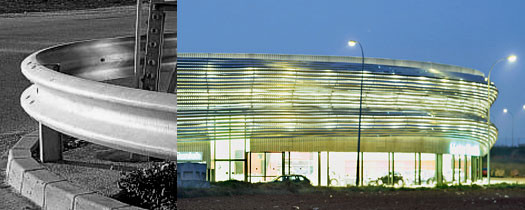
From the motorway we can see something new shining, there, there! At the entrance to Sabadell. Daddy, whassat? A bit concealed by the protection barriers of the road on which we are driving, both when going and when coming, there it stands, this thing that is drawing our attention. Until one day we drive into Sabadell. Stuck in the great queue of cars that are tiredly advancing, the occupants of the vehicles while the time away looking for something. It is the peculiar way we now have of entering cities. The hum of vehicles on the motorway behind us reminds us of the yearned-for speed at which we came, and now in front of us we see the great façade of a species of heavy metal shutter that is concealing something from us.
The intervention takes place in the city of Sabadell, an industrial textile centre in the vecinity of Barcelona. Specifically it is located in the industrial development by the south entrance to the city, in full view of the drivers on the Barcelona-Terrassa dual carriageway, next to the aero-drome. This is the last plot remaining in a built-up block with terraced constructions fronting the streets of Bernat Metge and Joan Costa i Deu, with a surface of just over thousand square meters of façade giving on to these two streets. We are on a half-built plot partially occupied by three bays with a metal structure, one of them with a greater centerline with tahn the other two. All this must be turned into premises for a high-end car dealer.
First we COMPLETE, a decision that entails a twist in order to face everyone driving along the motorway or entering the city of Sabadell. The original buildings are extended in two directions: the longitudinal extension of the three existing bays and the construction of half a bay in one of its two laterals, right up to the boundary with the street. In the first zone the peaked roof typology is maintained, with the addition of a series of perversities to permit natural light to penetrate. Come and see. To this end we adopted two different project mechanisms: where we want to gain height for the space immediatly below, we extended the ascending slope up to the necessay height and then completed the other slope in a symmetrical manner. A point of greatest heigh thus appears. The second mechanism is used to build half a flat roof that opens the way for the light that floods in through the other half, which does conserve the original slope. A point of lower heigth thus appears. Alternating slopes and planes on a diagonal allows us to keep the unity of the enclosure, where stretches of lesser greater height appears as rhythmical anecdotes. The metallic trusses that extend the bays rest on two concrete porticoes in the central part and metallic pillars in the ends. In the second zone, a metallic structure supports a roof that ascends when it approaches the street and ends up by crowning the façade with a curved line. This is the display space for the vehicles, where the metallic summers bridge the existing span between a line of steel pillars ant the continuous and self-supporting structure of the façade. The final manipulation of this space seeks the degree of comfort one might expect from a drawing room, a car sitting smoothly on a rug.
Then we DISTRIBUTE, and an intermediate level is built inside the original bays with a horizontal forging and concrete pillars parallel to the existing metallic structure. The height is determined by the requirements of the activities that take place on the ground floor. On the second level is a car park for the staff and the management and administration offices. Ont the entrance leval are the workshops, storerooms, after-sales services, sales and display space.
Thirdly, we COMMUNICATE, which means returning to the initial movements. The aim is to shape a façade that will transform the building into an advertisement of itself. Daddy, whassat? A metallic structure was erected to hold two shells. By means of fibre cement plates, the enclosure is built to make the building watertight and to finish the inside. The second one, more external and not waterthight, is made from mechanised stainless steel panels installed longitudinally, parallel to the streets and road. This curtain of waves shrinks at certain points to mark the accesses and to give a view of the car display zones. The ratio of scale between the open glazed parts and the curtain of waves insinuates two distances from which to perceive the building: one from the motorway and road, in movement, and another one a few meters from the building, static, from street level. The middle point is a no-man’s-land. You are either far away, reading an advertising hoarding, or in front of the cars on display, about to walk into the building. The clue to interpreting the shape is provided by the protection barriers of the motorway, from where one has privileged views of the building. A fleeting brightness.
